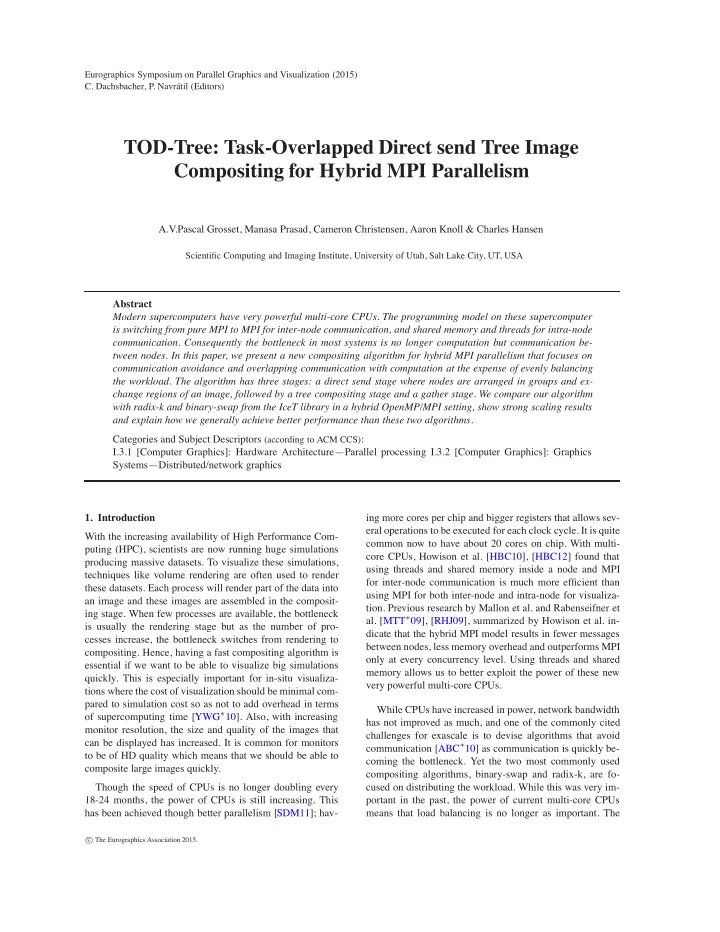

Eurographics Symposium on Parallel Graphics and Visualization (2015) C. Dachsbacher, P. Navrátil (Editors) TOD-Tree: Task-Overlapped Direct send Tree Image Compositing for Hybrid MPI Parallelism A.V.Pascal Grosset, Manasa Prasad, Cameron Christensen, Aaron Knoll & Charles Hansen Scienti fi c Computing and Imaging Institute, University of Utah, Salt Lake City, UT, USA Abstract Modern supercomputers have very powerful multi-core CPUs. The programming model on these supercomputer is switching from pure MPI to MPI for inter-node communication, and shared memory and threads for intra-node communication. Consequently the bottleneck in most systems is no longer computation but communication be- tween nodes. In this paper, we present a new compositing algorithm for hybrid MPI parallelism that focuses on communication avoidance and overlapping communication with computation at the expense of evenly balancing the workload. The algorithm has three stages: a direct send stage where nodes are arranged in groups and ex- change regions of an image, followed by a tree compositing stage and a gather stage. We compare our algorithm with radix-k and binary-swap from the IceT library in a hybrid OpenMP/MPI setting, show strong scaling results and explain how we generally achieve better performance than these two algorithms. Categories and Subject Descriptors (according to ACM CCS) : I.3.1 [Computer Graphics]: Hardware Architecture—Parallel processing I.3.2 [Computer Graphics]: Graphics Systems—Distributed/network graphics 1. Introduction ing more cores per chip and bigger registers that allows sev- eral operations to be executed for each clock cycle. It is quite With the increasing availability of High Performance Com- common now to have about 20 cores on chip. With multi- puting (HPC), scientists are now running huge simulations core CPUs, Howison et al. [HBC10], [HBC12] found that producing massive datasets. To visualize these simulations, using threads and shared memory inside a node and MPI techniques like volume rendering are often used to render for inter-node communication is much more ef fi cient than these datasets. Each process will render part of the data into using MPI for both inter-node and intra-node for visualiza- an image and these images are assembled in the composit- tion. Previous research by Mallon et al. and Rabenseifner et ing stage. When few processes are available, the bottleneck al. [MTT ∗ 09], [RHJ09], summarized by Howison et al. in- is usually the rendering stage but as the number of pro- dicate that the hybrid MPI model results in fewer messages cesses increase, the bottleneck switches from rendering to between nodes, less memory overhead and outperforms MPI compositing. Hence, having a fast compositing algorithm is only at every concurrency level. Using threads and shared essential if we want to be able to visualize big simulations memory allows us to better exploit the power of these new quickly. This is especially important for in-situ visualiza- very powerful multi-core CPUs. tions where the cost of visualization should be minimal com- pared to simulation cost so as not to add overhead in terms While CPUs have increased in power, network bandwidth of supercomputing time [YWG ∗ 10]. Also, with increasing has not improved as much, and one of the commonly cited monitor resolution, the size and quality of the images that challenges for exascale is to devise algorithms that avoid can be displayed has increased. It is common for monitors communication [ABC ∗ 10] as communication is quickly be- to be of HD quality which means that we should be able to coming the bottleneck. Yet the two most commonly used composite large images quickly. compositing algorithms, binary-swap and radix-k, are fo- Though the speed of CPUs is no longer doubling every cused on distributing the workload. While this was very im- 18-24 months, the power of CPUs is still increasing. This portant in the past, the power of current multi-core CPUs has been achieved though better parallelism [SDM11]; hav- means that load balancing is no longer as important. The c � The Eurographics Association 2015.
Recommend
More recommend